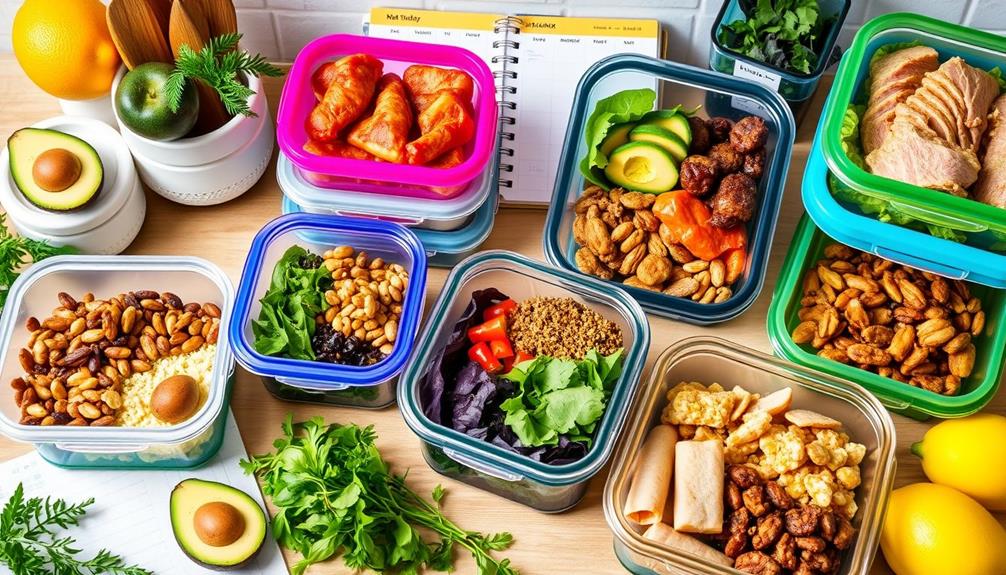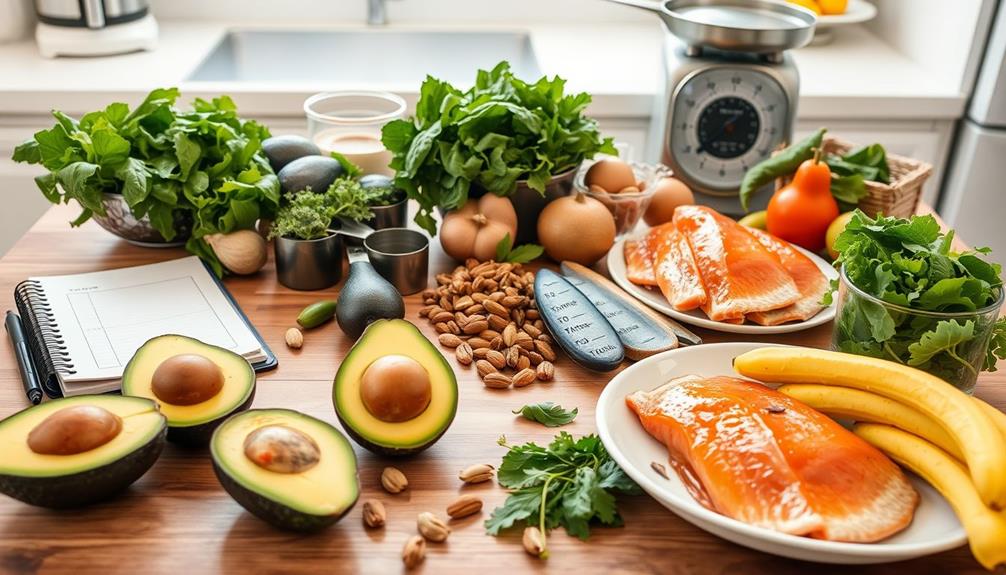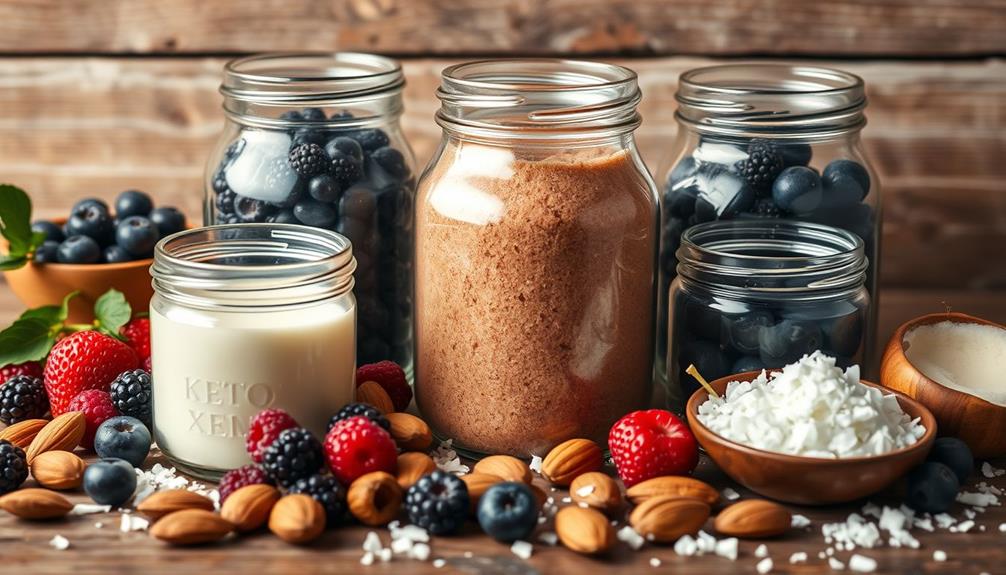To start a keto diet plan, you'll need to cut your carb intake to 20-50 grams daily and focus on high-fat foods. Aim for meals that consist of 70% fats, 20% protein, and 10% carbohydrates. Incorporate healthy fats like avocados, olive oil, and nuts, along with lean meats and non-starchy vegetables. Planning your meals helps maintain this balance, and consider tracking your food intake using an app to stay on track. Be prepared for initial side effects, like the keto flu, and make certain you stay hydrated. Stick around to discover more tips for long-term success on your keto journey! Once you have your meal plan in place, it’s important to stay consistent and dedicated to your keto diet. Make sure to also incorporate regular exercise, as it can help with weight loss and overall health. And remember, everyone’s body is different, so it’s important to listen to your own needs and adjust your diet accordingly. Now that you have the basics, get started with keto and enjoy the benefits of this low-carb, high-fat diet.
Key Takeaways
- Determine your daily carb limit, aiming for 20-50 grams to achieve ketosis and start your keto journey effectively.
- Focus on incorporating high-fat foods like avocados, olive oil, and nuts to make up 70-80% of your daily intake.
- Plan meals around low-carb vegetables such as spinach and broccoli to ensure you meet nutritional needs without exceeding carb limits.
- Gradually reduce carbohydrate intake over a week to minimize side effects like keto flu and enhance your body's adaptation.
- Utilize tracking apps to monitor your macronutrient ratios, ensuring you maintain 70% fat, 20% protein, and 10% carbohydrates.
Understanding the Keto Diet

When diving into the world of the ketogenic diet, it's vital to grasp its foundational principles. The keto diet is a high-fat diet that typically consists of 70% fat, 20% protein, and only 10% carbohydrates. To effectively enter ketosis, you'll need to limit your daily carbohydrate intake to 20-50 grams. This significant reduction in carbs shifts your body's reliance from glucose to fat for fuel.
Additionally, incorporating nutrient-rich foods, like high antioxidant options, can help support your overall health during this change.
The ketogenic diet originated in the 1920s as a treatment for epilepsy and has since gained popularity for its potential weight loss benefits and health benefits, such as improved blood sugar control in type 2 diabetes. By focusing on healthy fats—like avocados, nuts, and fatty meats—and minimizing foods high in sugar and grains, you can create a balanced plan that supports your goals.
It's essential to understand the difference between ketosis, a safe metabolic state, and ketoacidosis, which is dangerous. By recognizing these concepts, you'll set yourself up for success on your keto journey, ensuring that you enjoy the advantages of low carb diets while prioritizing your health.
Essential Foods for Keto

Stocking your kitchen with the right foods is vital for a successful keto diet. To get the keto diet help you need, focus on high-fat foods that should make up about 70-80% of your daily caloric intake. Include avocados, olive oil, nuts, and fatty fish in your meals.
Incorporating essential oils for wellness can also enhance your overall health while on the keto diet. While lean meats like chicken, pork, and beef serve as important protein sources, consume them in moderation to avoid excess protein that can convert to glucose.
Incorporate non-starchy vegetables such as spinach, broccoli, and cauliflower to provide necessary vitamins and minerals while keeping your carb intake low. Limit your fruit consumption to low-carb options like berries and tomatoes since most fruits contain higher sugar levels that can hinder ketosis.
Be mindful of your dairy choices; opt for high-fat options like cheese and heavy cream while avoiding low-fat or sweetened products that may have hidden carbs.
Meal Planning Strategies

Effective meal planning is essential for sticking to your keto diet and achieving your health goals. Start by creating a weekly meal plan that focuses on high-fat foods like avocados, nuts, and fatty cuts of meat.
To enhance your overall wellness during this dietary change, consider incorporating yoga for back pain as a way to alleviate any discomfort you may experience. Be sure to include low-carb vegetables such as leafy greens and cruciferous options to keep your meals balanced. Aim for a macronutrient ratio of approximately 70% fat, 20% protein, and 10% carbohydrates to effectively induce and maintain ketosis.
Batch cook keto-friendly meals like casseroles or soups in advance. This saves time during busy weekdays and reduces the temptation to grab non-keto options. Incorporate easy snack options such as hard-boiled eggs, cheese, and nuts to help manage hunger between meals while keeping your carb intake low.
To stay on track, keep a food diary or use a tracking app to monitor your daily food consumption. This will help guarantee you adhere to your carb limit of 20-50 grams per day.
Managing Side Effects

Managing side effects is essential for a smooth change to the keto diet. During the initial adjustment, you might experience what's commonly known as the keto flu, which can include fatigue and headaches. To combat these symptoms, make certain you're well-hydrated and increase your intake of electrolytes, particularly sodium and potassium.
It's also helpful to gradually reduce your carbohydrate intake over a week instead of making a drastic cut, allowing your body time to adjust and minimize side effects. Incorporating balanced diet practices can further support your adjustment into the keto lifestyle.
Incorporating high-quality fats—like avocados and olive oil—into your meals can help stabilize your energy levels and curb hunger as you adapt to a higher fat intake.
Don't forget to consume plenty of non-starchy vegetables to make certain you're getting enough fiber, which aids digestion and can reduce gastrointestinal discomfort often felt in the early stages of the keto diet.
If side effects persist beyond the adaptation phase of about three to four weeks, consider consulting a healthcare professional. They can help rule out any underlying issues or suggest adjustments to your dietary approach, making sure you stay on track with your keto journey.
Long-term Keto Success Tips

After overcoming the initial side effects of starting a keto diet, maintaining your success long-term requires a strategic approach. To achieve long-term weight loss, gradually reintroduce carbs while closely monitoring your body's response to guarantee you stay in ketosis.
Meal prepping is essential; use keto-friendly recipes to create snacks and meals that keep you away from high-carb temptations. It's also important to take into account your overall financial health while investing in quality food options, as creating a budget can help you manage expenses related to specialty ingredients and meal prep creating a personal budget.
Staying hydrated is vital for your overall health. Make sure to maintain your electrolyte balance by incorporating foods rich in sodium, potassium, and magnesium. This will help mitigate symptoms of the "keto flu" and promote well-being.
Regularly track your macronutrient intake using apps or journals to stick to your targeted ratios of 70% fat, 20% protein, and 10% carbs for peak results.
Engaging with keto communities or support groups can help you stay motivated. Share recipes, tips, and experiences to enhance your commitment and navigate challenges.
Frequently Asked Questions
How Do I Start My Keto Diet for the First Time?
To start your keto diet, calculate your macronutrient ratios, focus on high-fat foods, and prepare meals in advance. Stay hydrated, monitor your progress, and consult a healthcare provider if you have any concerns.
What Is a Keto Diet Plan for Beginners?
A keto diet plan for beginners isn't just about cutting carbs; it's about embracing healthy fats. You'll feel energized as your body shifts to burning fat, but initial challenges like fatigue can arise. Stick with it!
How Do Beginners Get Into Ketosis?
To get into ketosis, you'll need to drastically cut carbs, focus on high-fat meals, stay hydrated, and engage in regular exercise. Monitor your ketone levels to guarantee you're achieving the metabolic state effectively.
What Are the 9 Rules of Keto?
You'll want to limit carbs under 20-50 grams, prioritize healthy fats, moderate protein intake, stay hydrated, maintain electrolytes, plan meals, avoid grains and sugars, include low-carb veggies, and listen to your body for adjustments.
Conclusion
As you set forth on your keto journey, think of yourself as a ship setting sail into uncharted waters. With the right foods, careful planning, and a strategy for overcoming any bumps along the way, you'll navigate toward success. Embrace the changes, stay committed, and remember, every step brings you closer to your destination. Soon, you won't just be on the keto diet; you'll be thriving in a new lifestyle that supports your health and well-being.









